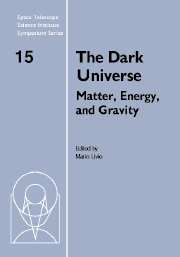Book contents
- Frontmatter
- Contents
- Participants
- Preface
- A brief history of dark matter
- Microlensing towards the Magellanic Clouds: Nature of the lenses and implications on dark matter
- Searching for the Galactic dark matter
- Hot gas in clusters of galaxies and ΩM
- Tracking the baryon density from the Big Bang to the present
- Modified Newtonian Dynamics and its implications
- Cosmological parameters and quintessence from radio galaxies
- The mass density of the Universe
- Growth of structure in the Universe
- Cosmological implications of the most distant supernova (known)
- Dynamical probes of the Halo Mass Function
- Detection of gravitational waves from inflation
- Cosmological constant problems and their solutions
- Dark matter and dark energy: A physicist's perspective
The mass density of the Universe
Published online by Cambridge University Press: 21 August 2009
- Frontmatter
- Contents
- Participants
- Preface
- A brief history of dark matter
- Microlensing towards the Magellanic Clouds: Nature of the lenses and implications on dark matter
- Searching for the Galactic dark matter
- Hot gas in clusters of galaxies and ΩM
- Tracking the baryon density from the Big Bang to the present
- Modified Newtonian Dynamics and its implications
- Cosmological parameters and quintessence from radio galaxies
- The mass density of the Universe
- Growth of structure in the Universe
- Cosmological implications of the most distant supernova (known)
- Dynamical probes of the Halo Mass Function
- Detection of gravitational waves from inflation
- Cosmological constant problems and their solutions
- Dark matter and dark energy: A physicist's perspective
Summary
One of the most fundamental questions in cosmology is: How much matter is there in the Universe and how is it distributed? Here I review several independent measures—including those utilizing clusters of galaxies—that show that the mass-density of the Universe is only ∼ 20% of the critical density. Recent measurements of the mass-to-light function—from galaxies, to groups, clusters, and superclusters—provide a powerful new measure of the universal density. The results reveal a low density of 0.16 ± 0.05 the critical density. The observations suggest that, on average, the mass distribution follows the light distribution on large scales. The results, combined with recent observations of high redshift supernovae and the spectrum of the CMB anisotropy, suggest a Universe that has low density (Ωm ≃ 0.2), is flat, and is dominated by dark energy.
Introduction
Theoretical arguments based on standard models of inflation, as well as on the demand of no “fine tuning” of cosmological parameters, predict a flat universe with the critical density needed to just halt its expansion (1.9 × 10–29 h2 g cm–3). Observations, however, reveal only a small fraction of the critical density, even when all the unseen dark matter in galaxy halos and clusters of galaxies is included. There is no reliable indication that the matter needed to close the universe does in fact exist. Here I review several independent observations of clusters of galaxies which indicate, independently, that the mass density of the universe is sub-critical.
- Type
- Chapter
- Information
- The Dark UniverseMatter, Energy and Gravity, pp. 96 - 101Publisher: Cambridge University PressPrint publication year: 2004



